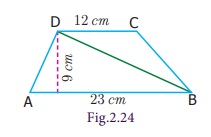Measurements | Term 1 Chapter 2 | 7th Maths - Area of the Trapezium | 7th Maths : Term 1 Unit 2 : Measurements
Chapter: 7th Maths : Term 1 Unit 2 : Measurements
Area of the Trapezium
Trapezium
We are familiar with parallelogram and rhombus.
What will happen in a parallelogram if one pair of parallel sides are not
equal? Can you draw it? How will it look like? The shape looks as given in
Fig.2.19.

A parallelogram with one pair of non-parallel
sides is known as a Trapezium.
The distance between the parallel sides is the height of the trapezium.
Here the sides AD and BC are not parallel, but
AB is parallel to DC.
Isosceles Trapezium
If the non - parallel sides of a trapezium are
equal (AB = CD) then, it is known as an isosceles
trapezium.

1.
Area of the Trapezium
ABCD is a trapezium with parallel sides AB and
DC measuring ‘a’units and ‘b’ units
respectively. Let the distance between the two parallel sides be ‘h’ units. The diagonal BD divides the trapezium into two
triangles ABD and BCD.
Area of the trapezium = area of ![]() ABD
+ area of
ABD
+ area of ![]() BCD
BCD
= 1/2 ×
AB × h + 1/2 × DC × h [since the
two triangles ABD and BCD have same heights]
Area of a trapezium = ½ × {h × (AB + DC)}
Therefore, Area of the trapezium = 1/2 × h (a+b) sq.units.

Example 2.10
Find the area of the trapezium whose height is
14 cm and the parallel sides are 18 cm and 9 cm of length.
Solution
Given, height (h) = 14 cm

parallel sides are (a) = 18 cm and (b) = 9 cm
Area of the trapezium = 1/2 × h (a+b)
= 1/2 ×
14 (18+9)
= 7(27)
= 189 sq. cm
Therefore, area of the trapezium is 189 sq. cm.
Example 2.11
The parallel sides of a trapezium are 23 cm and 12 cm. The distance between the parallel sides is 9 cm. Find the area of the trapezium.
Solution
Given, height (h) = 9 cm

Parallel sides are (a) = 23 cm and (b) = 12 cm
Area of the trapezium = 1/2 × h (a+b)
= 1/2 × 9 (23+12)
= 1/2 × 9 (35)
= 157.5
sq. cm
Therefore, Area of the trapezium is 157.5 sq. cm.
Example 2.12
The area of a trapezium is 828 sq. cm. If the lengths of its parallel sides are 19.6
cm and 16.4 cm, find the distance between them.
Solution
Given, Area of the Trapezium= 828 cm²

1/2 × h
(a+b) = 828
½ × h
(19.6+16.4) = 828
½ × h (36) = 828
h (18) = 828
h = 828/18
h = 46 cm
Therefore, distance between the parallel sides
= 46 cm
Example 2.13
The area of a trapezium is 352 sq. cm and the distance between its parallel sides is
16 cm. If one of the parallel sides is of length 25 cm then find the length of the other side.
Solution
Let, the length of the required side be ‘x’ cm.

Then, area of the trapezium = =1/2 × h (a+b) sq.
units
=1/2 × 16 (25+x)
= 200+8x
But, the area of the trapezium = 352 sq. cm (given)
Therefore, 200 + 8x = 352
⇒ 8x =
352 – 200
⇒ 8x = 152
⇒ x = 152/8
⇒ x =
19
Therefore, the length of the other side is 19 cm.
Think
1. Can you find the perimeter of
the trapezium? Discuss.
2. In which case a trapezium can
be divided into two equal triangles?
Mention any three life situations
where the isosceles trapeziums are used.
Example 2.14
The collar of a shirt is in the form of
isosceles trapezium whose parallel sides are 17 cm and 14 cm and the distance between them is 4 cm. Find the area of canvas that will be used to stitch the collar.
Solution
Given height (h) = 4 cm

Parallel sides are (a) = 17 cm and (b)
= 14 cm
Area of the trapezium = 1/2 × h (a+b) sq.
units
= 1/2 ×
4 (17+14)
= 1/2 × 4
(31)
= 62 sq. cm
Therefore, the area of canvas used is 62 sq. cm.

Though
there are various common types of cross sections available for irrigation
canals, trapezoidal cross section is widely used, because it prevents
overflowing during heavy rains, maximum water flow is possible with minimum
time (least frictional resistance) and safety measures can be taken easily
while someone or something falls into it.
Related Topics